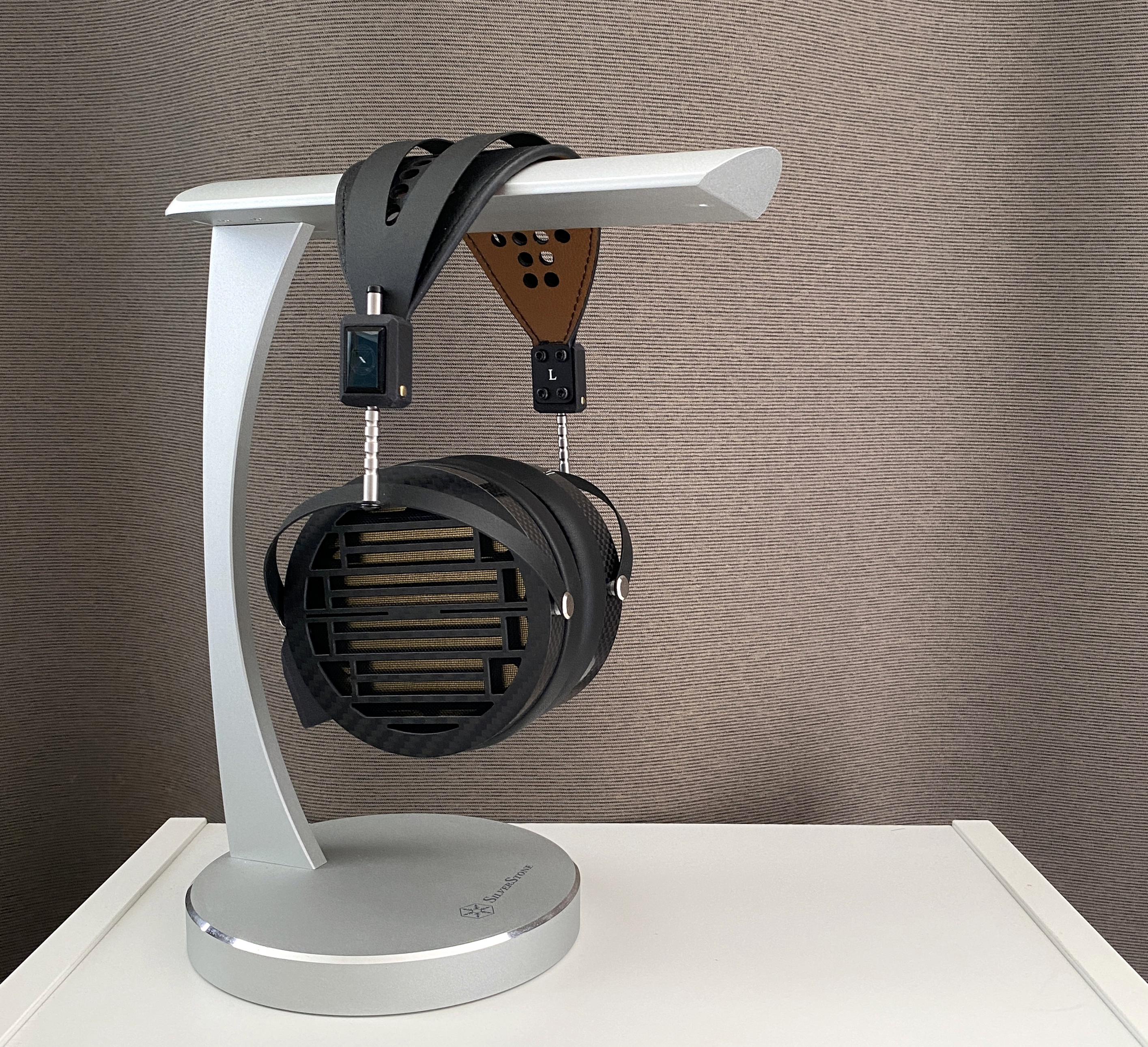
Intro:
Today, we turn our attention to the NAN-7, a planar magnetic headphone made by a boutique Chinese manufacturer goes by the name of ‘A-NAN’. Previously, the predecessor NAN-6 was also reviewed here. While I found it to be a worthy side-grade to the HE6se, offering a unique tuning that sets it apart from its counterpart, the landscape has shifted dramatically with the Adorama liquidation of the HE6se V2, which hit the market at an impressive $399 sale price. This remarkable value proposition has certainly raised the bar for other planar headphones in similar price range. With an exceptional blend of tonality and technicality, the only limitation of the HE6se V2 is perhaps the difficulty in driving it.
Enter the NAN-7, released in late 2022 with a price tag of around US$850 (without shipping and taxes). The question now becomes: can the newcomer justify its higher cost by offering features and performance that the HE6se V2 cannot? Furthermore, as the market for planar magnetic headphones becomes increasingly crowded, what distinctive qualities does the NAN-7 bring to the table to set it apart from the competition? Moreover, how does the NAN-7 fare against the well-established high-end planars on the market, such as the Arya Stealth, the Diana V2, or the Audeze LCD-5?
With these questions in mind, let’s dig into the review. This review will be longer due to the NAN-7 being a product from a small manufacturer (and also because… I need an excuse for having procrastinated for so long).
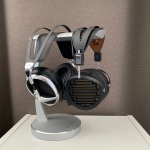
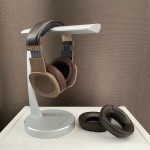
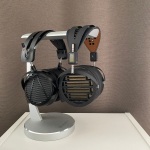
Overall impression:
To begin, the NAN-7 is an intriguing headphone to review. Inside the box of NAN-7 are three different sets of pads, a clear message by the maker that pad-rolling is encouraged with these headphones. In this review, they’ll be referred to as the default hybrid pads, the round pleather pads, and the perforated leather pads. As such, the NAN-7 defy easy categorisation, as each pad makes for a different sound profile.
It is important to note that despite the flexibility offered by the pad options, the NAN-7 still possesses its own sonic character. Generally speaking, the NAN-7 has a neutral-ish tuning with boosted bass and solid mids; A good comparison might be the Hifiman HE6se V2 or the Susvara with more ‘blood and flesh’ ie. a greater sense of bass and mids energy especially in terms of the physicality of impact. The NAN-7 boasts a powerful and engaging bass response, reminiscent of the Hifiman HE500 or the earlier Audeze LCD series. However, rather than being an intense headphone, its bass remains non-distracting thanks to exceptional clarity and composure. Impressively, the NAN-7 has showcased its capabilities as one of the most technically proficient planars, dare I say, regardless of price point. The sense of resolution it offers is exceptional, with no single frequency overshadowing another, resulting in a well-organised presentation of detail. Imaging, another notable strength, is reminiscent of the HE6 OG, offering excellent depth and centre image definition.
Perhaps the most striking aspect of the NAN-7 is its remarkable dynamics – a trait seldom found in planar headphones. It is often observed that, in comparison to traditional moving-coil (dynamic) headphones, planars may lack impact or punchiness, even when bass levels are similar. The NAN-7, however, challenges this stereotype, delivering a hard-hitting bass reminiscent of the Abyss headphones. This characteristic is also supported by frequency response measurements, which reveal some 3dB subbass boost (not attributable to an air gap, as demonstrated by the leakage test measurement below).
In the following sections, I will provide a brief overview of the impressions of each pad.
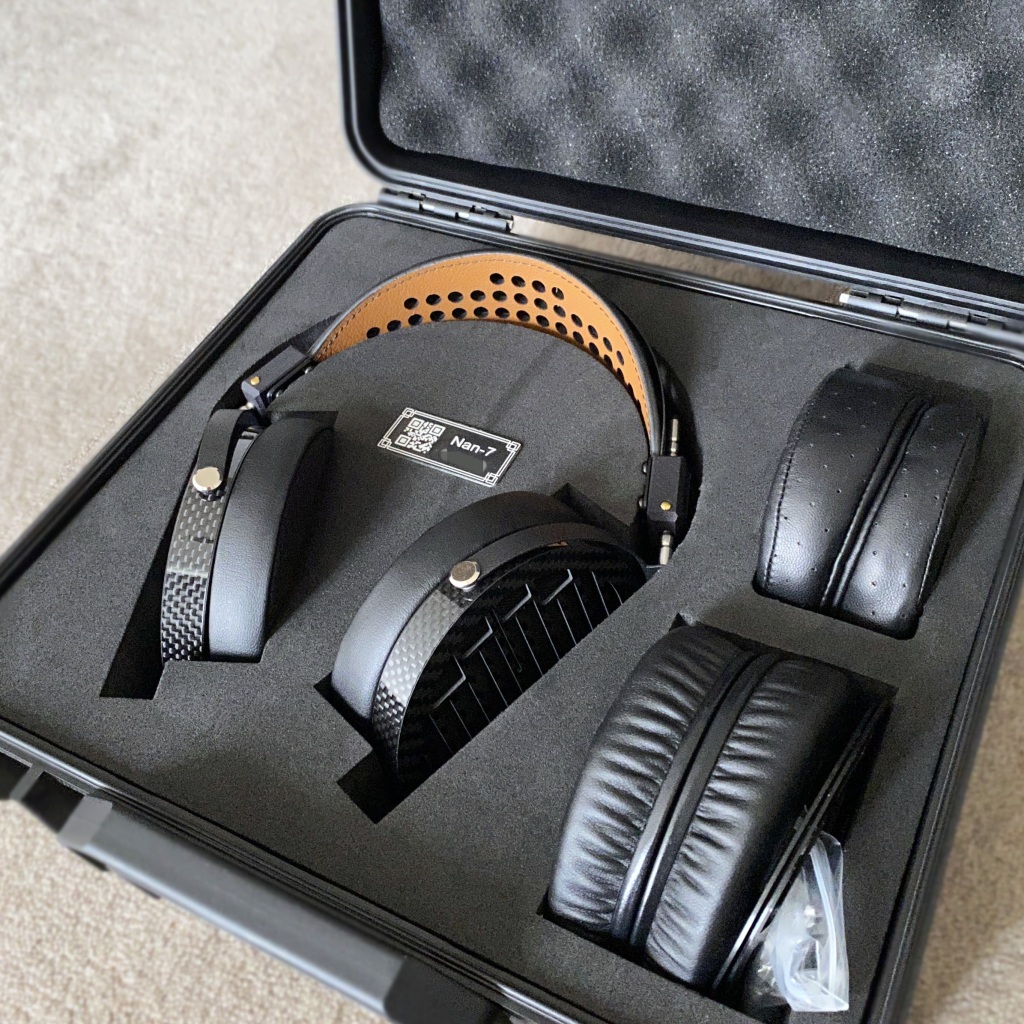
1. Default hybrid pad:
Marked by an unusual sub-bass prominance, somewhat meaty lower mids, and spaced out upper mids, the default hybrid pads evoke a tonality similar to the Hifiman house sound. Having a scoope in the 1-3khz region, according to this tuning philosophy, enhances the sense of acoustic space like being in well-designed concert halls. The hybrid pads take this concept to another level, as the scoope reaches 5-6dB at 1.5kHz, a step further than most Hifiman planars like the HE6se or the Arya.
The treble, while mostly linear, veers towards the more consevative side of things. The HE6se V2 serves as a close reference point, although the NAN-7’s bass and mids are considerably more prominent. Vocals, though clear and focused, might occasionally be perceived as thicker and boxier than usual. As these pads come pre-installed on the NAN-7, they likely represent the intended primary sound profile, which I find more well-suited for genres like orchestral, instrumental jazz, and electronic music, among others.
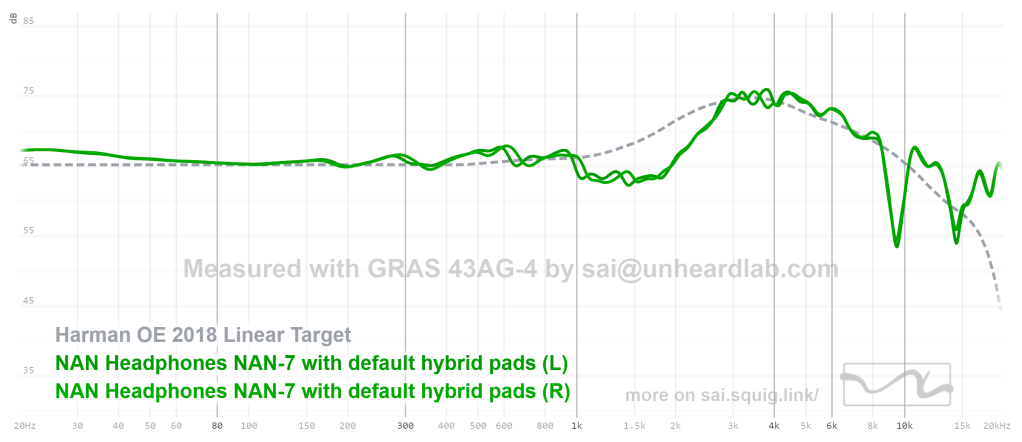
2. Perforated leather pad:
Compared to the hybrid pads, the perforated leather pads bring a discernible tightness to the bass, yielding a faster, leaner, and more dynamic sound. The midrange becomes generally more linear, although there’s a touch of honkiness around 1kHz emphasising nasal tones in vocals that some listeners might not find appealing. The treble, on the other hand, is smoother and less prone to dryness or sibilance, albeit with slightly reduced extension and airiness in the highest octaves.
In terms of genre compatibility, these pads prove more amenable to modern music styles such as pop and rock, where vocal timbre is of utmost importance. While the emphasised nasal tones may be noticeable, they are not sufficiently pronounced to disrupt the overall tonal balance. In fact, some listeners may prefer this presentation if their favorite vocalists’ performances are enhanced by an emphasised nasal quality.
* as a side note, leather pads with more perforation/higher degree of ventilation have proved to eliminate the 1kHz bump, evidenced by the FR measurement of the Dekoni Fenenstrated Sheepskin pads for Fostex THX00.
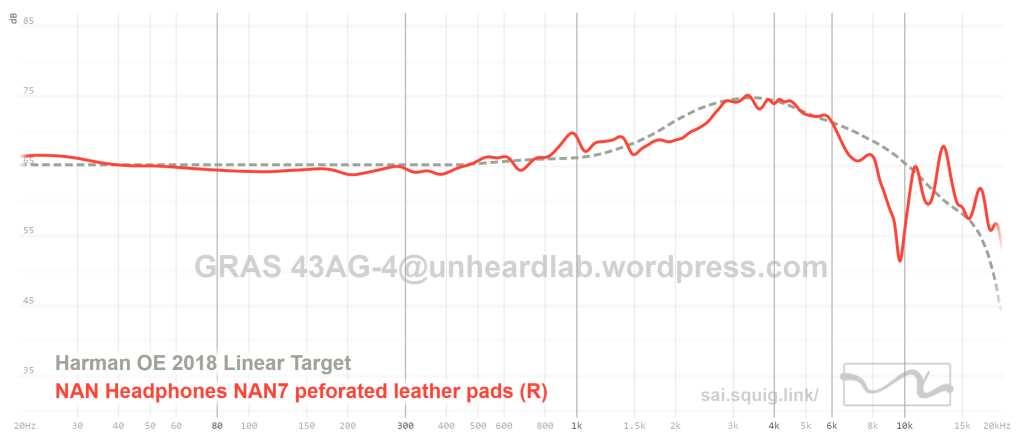
3. Round pleather pad:
In short, this is arguably the worst pad option. It’s not angled – that means spatial qualities can’t be good. More importantly, it pretty much screws up the whole tuning.
In some ways, I find that this pad to be an extreme version of the perforated leather pad. Vocals and mid-range instruments become strikingly forward and boxy. Piano tones, in particular, have an strange glare to them, rendering extended listening sessions uncomfortable. Meanwhile, the treble is imbued with added zest; while this can initially excite the ear, it may also lead to fatigue over time. Bass is fine, as the pleather material refines the sub-bass boost, making it tighter than with the default hybrid pads. The deal breaker lies in the midrange timbre, which is significantly disrupted by a drastic boost between 800-1200Hz. Coupled with recessed upper mids, this combination results in harmonic imbalance that colours instruments way too much than my liking.
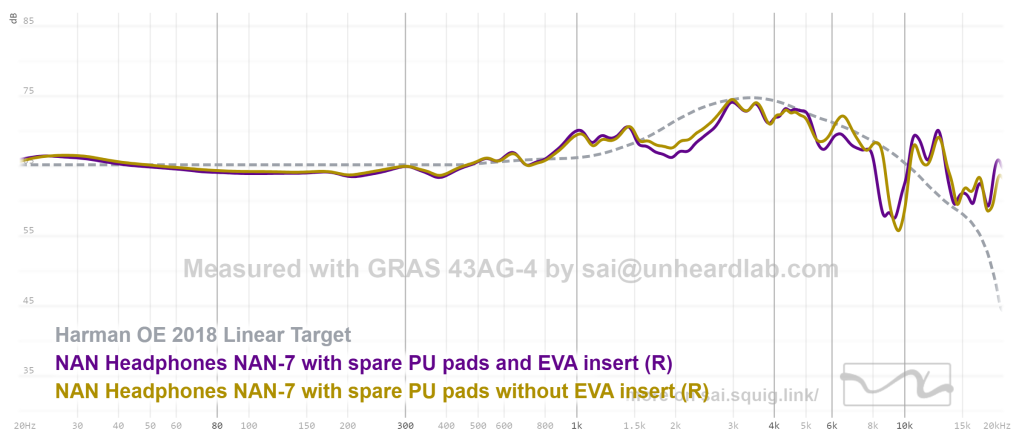
Tonal balance
In this section, what I usually do is to simply break down the tonal balance into three frequency ranges. However, three sets of pads each with their own character again complicates this task. It is impossible to describe the tonality of a headphone without reference to the actual pad used. So, I will instead base the discussion on the Hifiman Pali pads, found on the latest versions of the Sundara and HE6se. If you happen to own the NAN-7, I recommend the Pali pads as a neutral reference point when you roll pads.
This is because, on the one hand, the Pali pads bring out perhaps the most neutral presentation of the NAN-7 driver (although the differences between the Pali pads and the stock hybrid pads are not night and day difference). On the other hand, many of the viewers here are probably familiar with Hifiman headphones like the Sundara or HE6se that come with this pad. Therefore, using the Pali pad as the reference point here would probably help to show how the drivers of the NAN-7 are tuned, in a more comparable way.
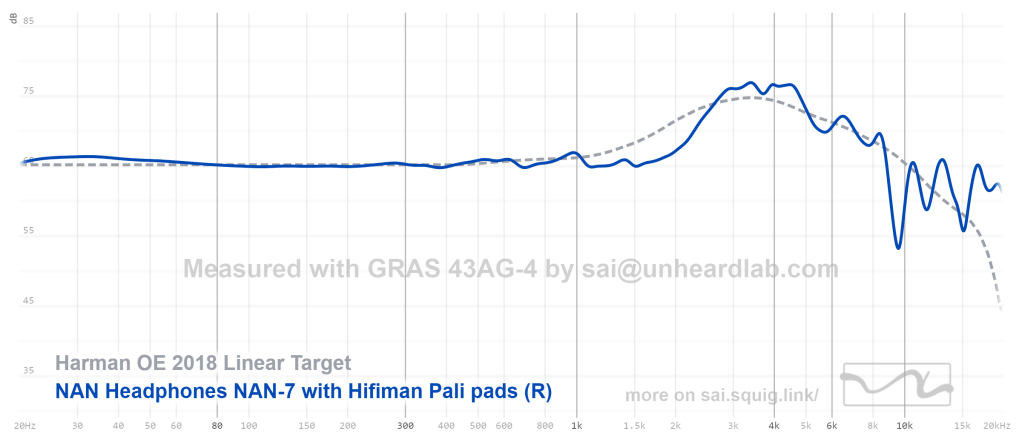
Manual sine-sweep:
A manual sine sweep on my head revealed peaks at 4.3k, 8.8k, 11k, and 12.5kHz. None of the peaks are particularly strong, though that between 8-9kHz is perhaps the most apparent. The 9.5khz dip did not come across to my ear. Note the perception of treble varies A LOT from person to person especially from 10khz. You may or may not hear the same peaks or dips depending on headphone positioning, your own HRTF and/or headphone unit variation.
Bass:
One of the most dynamic bass in a headphone: tight, punchy, and full of impact. With loads of sub-bass oomph and rumble, it offers a fantastic sense of momentum, making it perfect for orchestral music like the opening fanfare of “Also sprach Zarathustra” by Richard Strauss. The NAN-7 delivers a majestic bass ambiance, authority, along with an impressive sound field depth. The sense of impact is easily one of the best I have heard from planar headphones, as also showcased by the synth notes in the first minute of ‘Fluids’ by Yosi Horikawa.
In some ways, the excellent bass slam of the NAN-7 is similar to what you would get from introducign a high-Q resonance by breaking the seal of a low Fs planar driver. The main difference here is that the resonance frequency is super low at around 20hz. As such, the bass boost retains the subbass frequencies fully, which translates into a bass response that’s both deep and snappy at the same time. This might be related to what the NAN-7 manual refers to as an innovative ‘pressure-balanced chamber structure.’
But it’s not just about the bass quantity—the NAN-7 also excels at portraying the contrast between strong and weak notes. Take the ghost kick drum notes in Led Zeppelin’s ‘Fool in the Rain’, for example, which add a complex, jazzy groove to the music. Headphones with muddy bass might struggle to distinguish between strong and weak drum hits, but the NAN-7 handles it with ease.
As it proves, the NAN-7 demonstrates the ability to reproduce bass that is leagues above mid-fi planars like the Hifiman Sundara or the Moondrop Venus. The HE6se V2 may be close in terms of how nimble and tight the bass can sound, but the NAN-7 outclasses it in terms of slam and the scale of impact. Finding a close comparison for this level of bass performance is tough, and the Diana V2 with bass port pads might come closest. Both have incredibly dynamic and punchy bass, with the Diana V2 offering slightly tighter, harder-hitting bass, while the NAN-7 features a rounder, more diffuse and atmospheric presentation.
Of note, the NAN-7’s outstanding bass performance doesn’t change much with different pads, which isn’t always true – in some cases perforations can cause significant bass leakage. Even when using the included perforated leather pads, the bass maintains its slam and authority, while trading a bit of the oomph for tightness and speed. Overall, I have no complaints whatsoever for the bass performance on the NAN-7. It is without doubt, class leading.
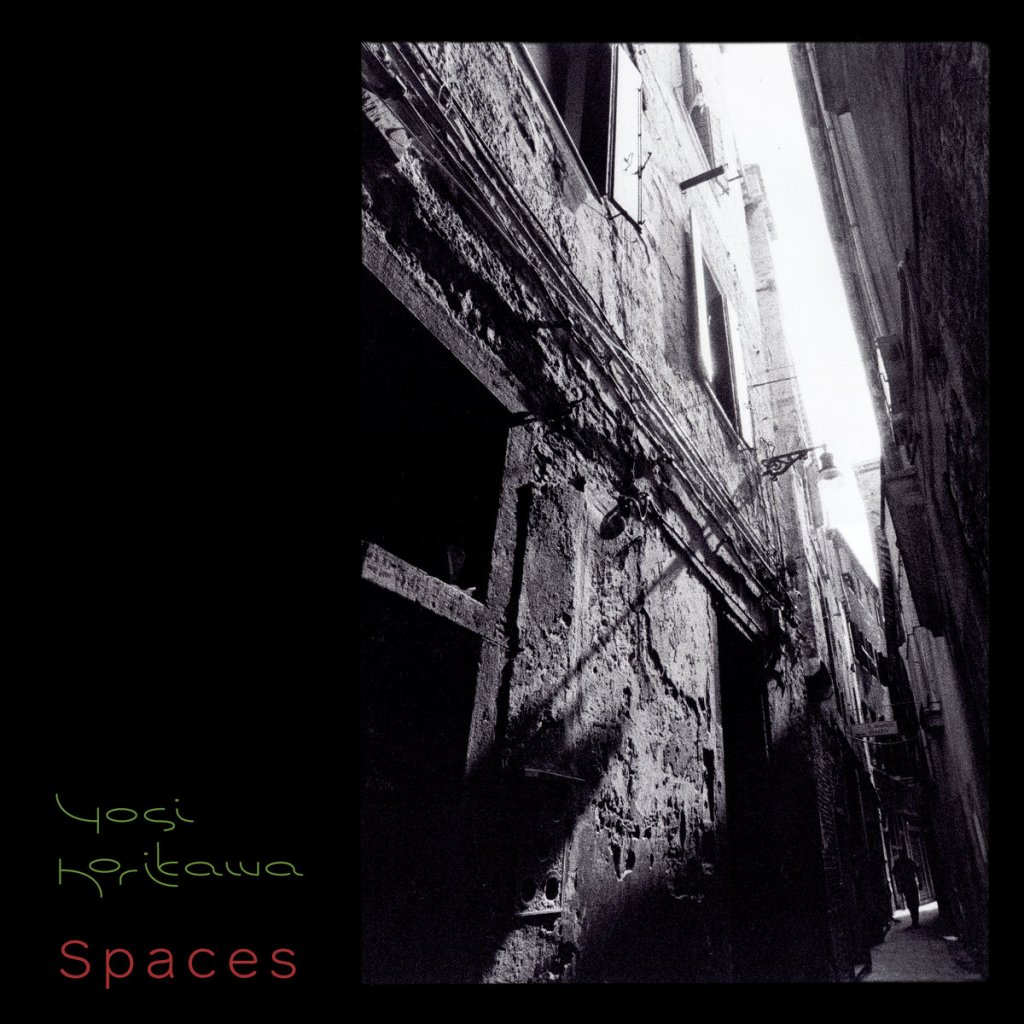
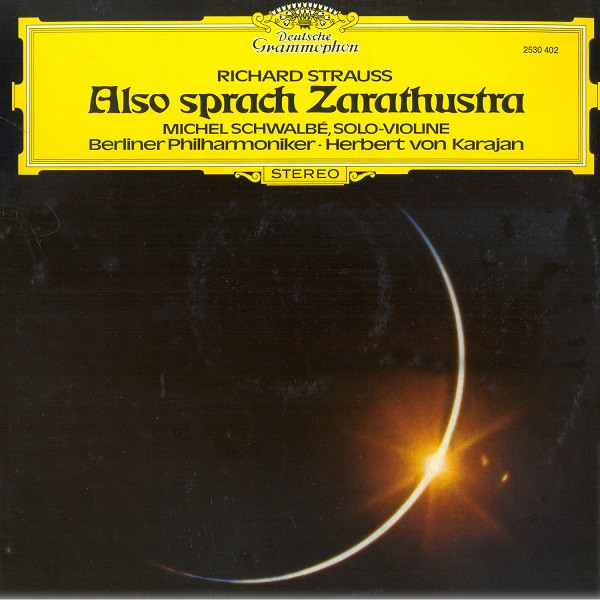
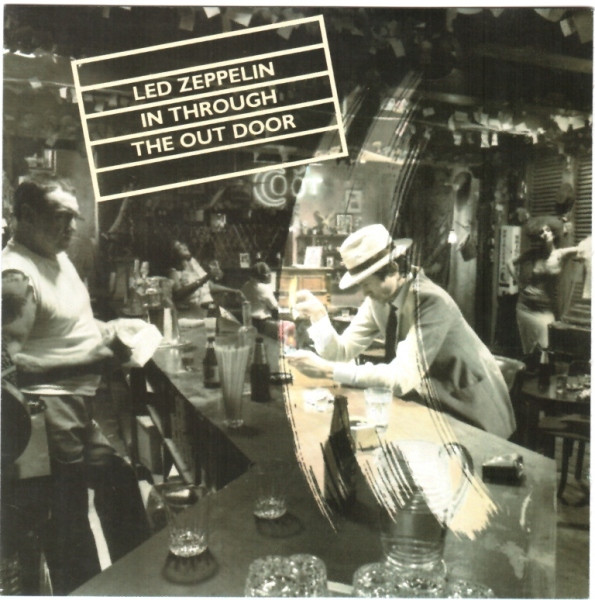
Mids:
Midrange on the NAN-7 evokes the signature Hifiman style – slightly spaced out than usual while remaining articulate. Midrange instruments exhibit accurate timbre, and vocals possess a substantial sense of body without ever becoming shouty. While the default hybrid pads may lend vocals a slightly meaty quality, the Pali pads rectify this boxiness for a more neutral presentation. However, it is far from what some might describe as a ‘thin’ sound. Quite the opposite, the NAN-7’s midrange is never hollow or lean but replete with depth and richness. In comparison, vocalists on both the HE6se V2 and the Hifiman HE1000 V2 tend to sound a tad thinner.
That said, the rather linear mids to treble transition on the NAN-7 doesn’t always offer the smoothest vocal presentation, and it largely depends on the quality of the music mix. In general, well-mastered modern recordings, like Youn Sun Nah’s “Calypso Blues”, and remastered vintage mono recordings like Nat King Cole’s “Mona Lisa”, come acorss as full and vivid. However, occasionally accentuated consonant tones like that the first ‘see’ in Holly Cole Trio’s “I Can See Clearly Now” may come across somewhat dry, though not enough to be labeled ‘shrill’. In this way, the NAN-7’s midrange can be considered as striving for an honest reproduction of music without excessive polish, as evidenced by the FR measurements where the mids is mostly linear aside from the scoope between 1-3kHz.
Comparing to headphones with exemplary midrange timbre, such as the HD600 or the LCD-5, the NAN-7’s mids is not as liquid, though the sense of articulation is actually not far behind the LCD-5. Comparing to the Meze Elite, where the mids has a wonderful sense of laid-back smoothness and velvety feel, the NAN-7 lacks the gimmicry to sound as magical, though its reproduction of midrange instruments is arugably much more faithful to the recording. A close comparison may be the HE6se, where the mids often feels a little too polite due to the 1-3kHz recess. Vocals sound fuller and slightly more forward on the NAN-7, while both exhibit slightly accentuated bites and grains. To improve midrange tonality, one option is to use leather pads with a smaller front volume. The bottomline is, the vocal timbre of the NAN-7 sits about on par if not slightly better than similarly priced planars from Hifiman, such as the HE6se V2 or the Hifiman Arya Stealth. But if vocal smoothness is strictly your priority, then the Audeze LCD-3 or the ZMF Auteur might be more suitable options.
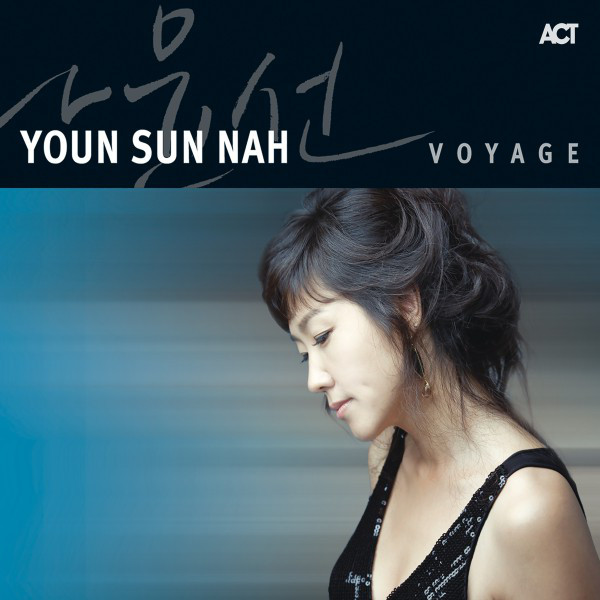
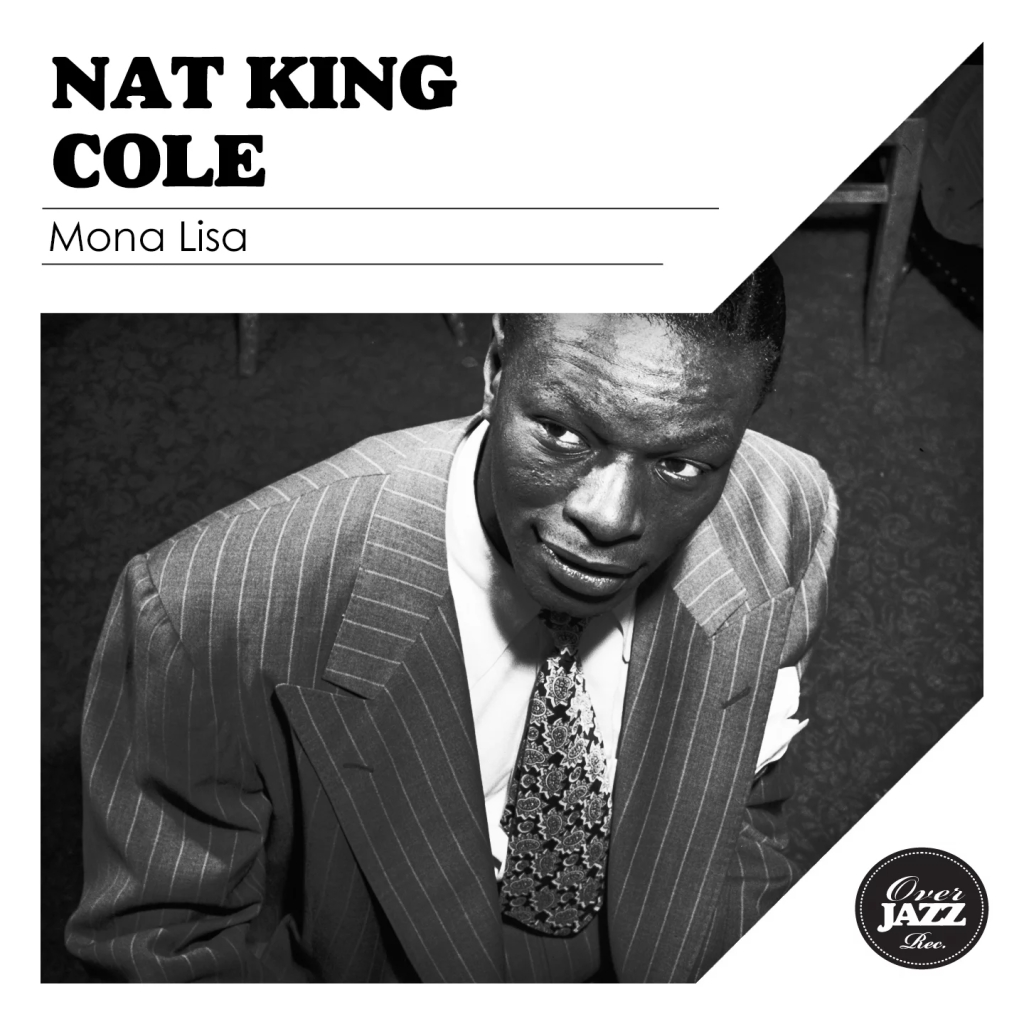
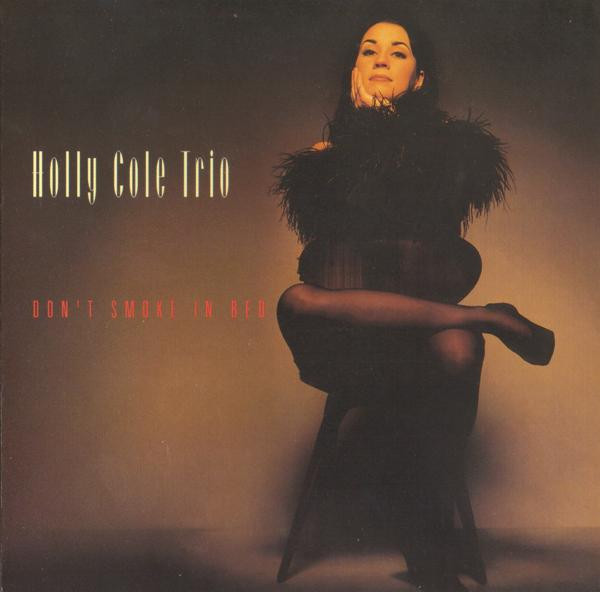
Treble:
Continuing with its neutral approach, the treble on the NAN-7 presents a balanced take on the music – neither too dark or too bright, while the balance of harmonics leans toward the upper octaves. Instruments have enough energy to sound clear and sharp, while consonant tones in vocals are generally not accentuated. Sibilance is not an issue unless the music is mastered with added emphasis on that.
Indeed, some may even find the NAN-7’s treble to be on the darker side, particularly if they are used to the mid-treble emphasis commonly found in headphones such as the T1, the HD800, or the Arya/HE1000. Breaking down the treble composition, I find the mid-treble (6-8kHZ) on the NAN-7 to be more controlled, presenting a subtler approach to the elements of ‘sheen’ on instruments that are often found emphasised in TOTL cans. But at the same time the upper treble maintains a decent amount of air to sound natural and open. Therefore, it has more to do with a different approach to harmonic balance. Overall, I find 6-8kHz to be well balanced with midrange tones, while upper treble above 10kHz can get ever-so-slightly hot at times, causing some percussion instruments to sound a bit zingy (think more aggressive recordings where the sibilance peak is within -10dB of the fundamental tone).
A good reference point is the Hifiman HE6se V2, a mid-fi planar that many consider to have exemplary treble timbre that gives many flagship headphones a run for their money. Treble on the NAN-7 comes across a bit more balanced, while the HE6se V2 sound a little ‘cleaner’ by comparison. This can also be attributed to the NAN-7 having more bloom in the bass and body in the mids. In terms of treble clarity, the NAN-7 surpasses the HE6se V2, delivering a more heightened sense of resolution. As such, the treble style and quality of the NAN-7 are somewhat reminiscent of the HE6 OG. While the NAN-7 may be a bit more conservative therefore not as ‘crisp’, there is a comparable level of clarity and incisiveness.
Overall, the style of treble presentation is similar to the Hifiman gold-plated planars, though not as crisp or airy as the Susvara. While the sense of clarity is scarily close to the TOTLs, the NAN-7’s treble falls slightly behind in the degree of smoothness. The Audeze LCD-5 and the Meze Elite are examples of effortless transition between mid- and upper-treble, making them more tolerant to modern music genres.
Interestingly, the NAN-7’s treble brings to mind a darker version of the Sennheiser HD800S (ie. EQed with a -3dB filter, Q=3.0 at 6kHz) which is known for its slightly brighter highs but still within the ‘neutral’ range. The HD800S, unlike its predecessor the HD800, doesn’t have as prominent resonance peaks in the upper octaves, so that the added energy rarely distracts one from the music. This results in a discernible brilliance to instruments without overly compromising timbre. A good example can be found in the shimmering percussion of Makiko Hirabayashi’s “Moon Bells”. So, despite the NAN-7 and HD800S being distinctly different sounding headphones, their approach to treble presentation share a certain degree of resemblance.
In summary, if the mid-treble and upper-treble transition were more refined, the NAN-7 would be more versatile across different music genres. In this regard, the NAN-7 is again similar to the Susvara. In fact, my only complaint for otherwise nearly perfect Susvara is that the treble sparkle can occasionally get a bit hot. But by preserving the zingy elements of the music, a headphone can potentially reproduces the timbre of instruments, like the accent of crash cymbal in a jazz improvisation or the penetrating brilliance of a violin solo, more faithfully. Metal enthusiasts who appreciate a touch of rawness are also likely to enjoy the clarity of the edges of instruments on the NAN-7, coupled with its exceptional bass dynamics. The bottom line is that treble presentation varies most significantly with pad options, as shown in the measurements above. Overall, while it could benefit from some refinement, the NAN-7’s treble is undeniably impressive in terms of clarity and faithfulness to the recording.
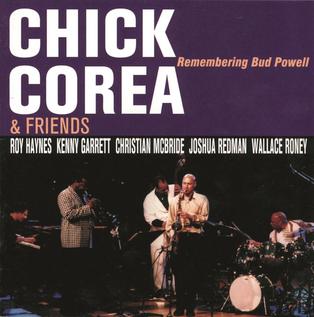
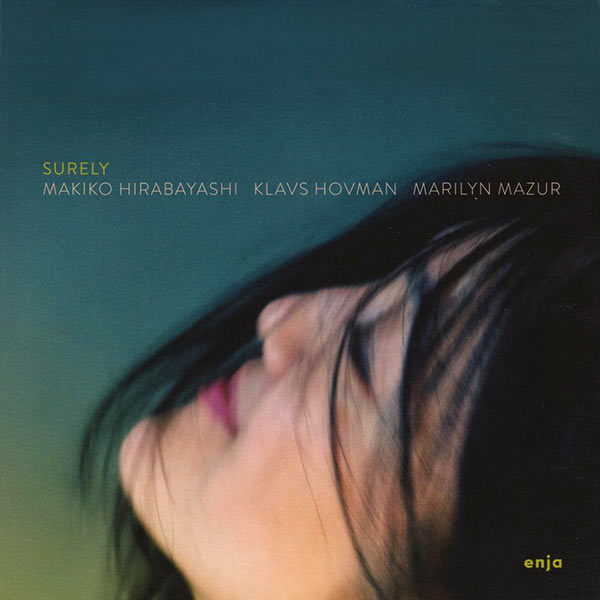
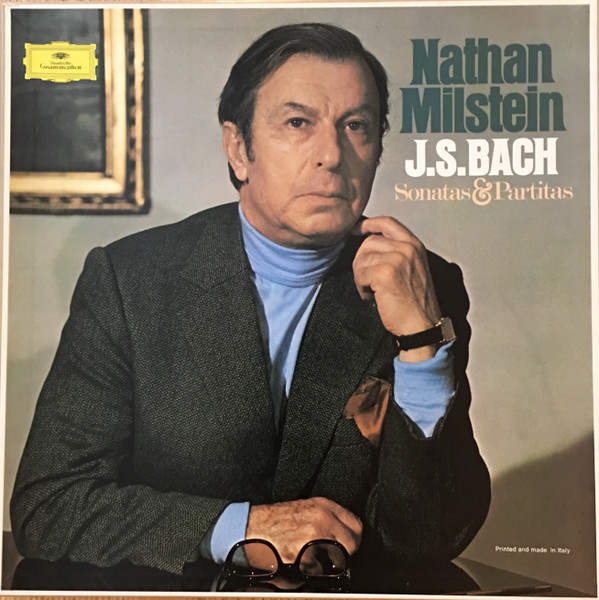
Other qualities:
- Space and stage: The NAN-7 is proficient in spatial qualities though perhaps not class leading. When reproducing sounds meant to come from a distance, such as the sound effects in the opening of Michael Jackson’s “Thriller”, the NAN-7 maintains a natural sense of distance without exaggeration. When it comes to reproducing the soundstage of a live orchestral recording, the NAN-7 does not suffer from issues of compression or distortion. The Susvara takes the cake with a much wider horizontal stage and more diffused sense of air, while the NAN-7 is not far behind in portraying depth. When compared to more intimate sounding headphones like the LCD-5, the NAN-7 offers a decernibly wider horizontal stage and grander sense of sound field. Overall, the NAN-7 has a reasonably-sized, conventionally-shaped soundstage – there is no magic there, but nothing to be complained about either.
- Imaging and positioning: The imaging capability of the NAN-7 is excellent. Vocalists are positioned front and center with a vivid sense of presence. Generally images are not very close-up, and there is a good sense of depth between the front image and those at the sides. Commendably the front image is very distinct and focused, where there is a strong sense of the vocalist ‘being there’. This is impressive, as imaging is typically considered a weakness of planar headphones. In comparison to top dynamic headphones, planars often exhibit fuzzier imaging and weaker directionality due to the larger size of planar drivers. Designing a chassis that can accommodate a large planar driver at an optimal angle without becoming overly bulky or heavy is a challenging task. While angled pads can help mitigate this issue, highly angled pads can easily affect the tuning of the headphone by introducing a deep front volume. In contrast, headphones like the Beyerdynamic T1, which come with highly angled drivers, offer a stunning sense of directionality. While the NAN-7 may not rival the T1 in terms of directionality and may not be the best option for gaming, overall the sense of positioning on the NAN-7 is still great. It offers a solid and tangible reproduction of sound images with a sense of depth that surpasses many planar headphones in its price category, and compares favourably to higher-priced options such as the Arya Stealth and the Diana V2.
- Clarity (a.k.a. ‘detail’): The NAN-7 is an excellent performer that can rival the TOTLs. It excels at pulling apart different elements of complex musical arrangements. Even the more subtle elements in the music sound impressively clear and distinct. Initially, I did not perceive the NAN-7 to sound as ‘resolving’ as other top-of-the-line headphones, but I later realised that it has more to do with the prominence of bass in the NAN-7’s sound profile. Upon closer listening, I found that the details are never masked over, but conveyed in a more ‘unruffled’ manner. One of the standout qualities is its impressive composure during busy passages. The NAN-7 can allow you to distinctly track individual instruments, like the bass guitar line in a cacophony of crashing cymbals, distorted guitar walls, and dramatic keyboard melodies of a post-rock crescendo. In comparison to the HE6se V2 and the Diana V2, the NAN-7 offers a better sense of instrumental separation, while the Susvara remains a slightly more resolving headphone. Overall, the NAN-7 exhibits an excellent sense of clarity, perhaps just slightly shy of those at the very top, which is remarkable considering its price point and its emphasis on bass impact.
- Dynamics and impact: Unlike some planars that suffer from soft transients or compressed dynamics (such as the Aeon Open X), the NAN-7 is free from these issues. The dynamics and impact of the NAN-7 are truly exceptional and set it apart from other planars in the competition. While the NAN-6 has good impact, it falls behind the HE6se V2 in terms of contrast and bass micro details. The NAN-7 is clearly a league above the HE6se V2, which is already an excellent performer in this regard. The sense of physicality on the NAN-7 is simply magnificent and stands out even among other top-of-the-line planars. While the Meze Elite has more bass quantity, the NAN-7 surpasses it in terms of incisiveness, impact, and extension. The NAN-7 not only excels in macrodynamics but also in capturing subtle changes in quieter elements of music, such as a faint drum roll in the background of an orchestra. Even compared to the Diana V2, the NAN-7 performs admirably in this regard, and it’s only when you reach the level of the LCD-5 that you may find better finesse in portraying microdynamics. But then again, the NAN-7 offers a much fuller sense of punch and impact than the LCD-5. If one were to nitpick, the transient attack on the NAN-7 could be slightly more nimble, although this is not saying it’s a slow headphone by any means. Overall, the NAN-7 has excellent transients comparable to the HE6 OG, and is faster than the Diana V2 or the Meze Elite in the grand scheme of things.
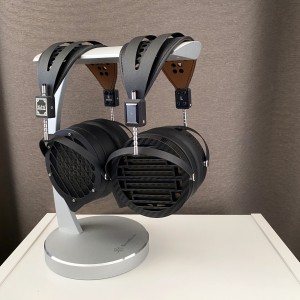
Comparing to the NAN-6:
Given that the NAN-6 is the only other product offered by the same manufacturer, it is logical to have a dedicated section for direct comparison between the two.
Despite their many structural similarities, the two headphones actually exhibit quite different sound characters. In my review of the NAN-6, I noted its smooth, mellow, almost laid-back presentation of the midrange, which makes it ideal for vocal-oriented music. It has decent bass extension and impact, though not awe-inspiring. The treble straddles somewhere between Hifiman and Audeze headphones, where there is a good balance between clarity and smoothness. As such, the NAN-6 has a distinct sound that leans towards a more specialised, genre-specific headphone. I thoroughly enjoy its calm and effortless rendition of folk, country, R&B, classic jazz, and various pop music genres. While the NAN-6 may not boast top-tier technicality, it immerses you with its soothing style.
On the other hand, the NAN-7 is a headphone that unabashedly showcases its technical prowess. There is much more of a wow factor: with magnificent bass slam and treble clarity, the NAN-7 can easily impress those who are used to hearing TOTL cans. Midrange though is not as liquid as the NAN-6. The key commonalities between the two NAN headphones are perhaps a well-supported lower midrange and a great sense of front imgaing. Overall, the timbre of instruments on the NAN-7 is more accurate, but the trade-off for this higher level of resolution is that the NAN-7 is a less forgiving headphone. This is akin to the situation with the Sennheiser HD800S, where fans of the magical midrange of the HD6 series may find the flagship model less appealing. In the case of the NAN-7, while its tonal balance is more neutral compared to the HD800S and the NAN-6, whether one appreciates its slightly more V-shaped presentation and its ability to reveal every nuance of the music is a matter of personal preference.
Conclusion and value:
So that’s what the NAN-7 is about. Full of raw, unbriddled energy and potentiall, making it a great option for seasoned headphone enthusiasts who want to explore what a uniquely designed, finely crafted and technically highly capable planar driver can do. I also encourage experienced users of Hifiman planars to try the NAN-7 if there was the opportunity, as it presents a similar yet different sound profile that is more focused and energetic. Admittedly, the NAN-7’s tonality may not be as natural as the HD600, as well-rounded as the Meze Elite, or as expansive as the Susvara, and its straightforward character may not appeal to all. But this is also something EQ or pad-rolling can potentially fix. Interestingly, I found that the Susvara pads impart a subtle, understated smoothness that tempers the energetic nature of the NAN-7, offering a more effortless listening.
However, this is not to suggest the NAN-7’s default tuning is subpar. In fact, as one can also see from its FR measurement, the NAN-7’s tonality is reasonably close to neutrality. Comparing to most headphones at its price range, the NAN-7’s tone is already very good. It is only when placed alongside legendary references like the HD600, or flagships like the Susvara and the LCD-5 that the NAN-7 appears to lack the final touch of refinement. In terms of technicalities, the NAN-7 comes alarmingly close to the top dogs, even surpassing them in certain aspects.
Admittedly, my comparisons may have been rather stringent, as I pit the NAN-7 against some of the finest headphones on the market. Indeed, I evaluated the NAN-7 alongside their most notable strengths, such as the Susvara’s soundstage, the LCD-5’s mids, and the Diana V2’s bass. However, considering the technical prowess of the NAN-7, I believe such comparisons are warranted. As a product from a small manufacturer, it must offer something unique to justify its value proposition. I am pleased to report that the NAN-7 has successfully accomplished this task.
In conclusion, the NAN-7 represents outstanding value at around US$850. With pad-rolling or EQ adjustments tailored to your preferences, you can fully exploit the NAN-7’s exceptional technicalities. Even the stock tuning with the hybrid pads or perforated leather pads delivers a satisfactory listening experience, although there may be some limitations in terms of genre compatibility.
Pros: exceptional technicality that punches way above its price point; one of the best dynamics; remarkable clarity and separation; excellent imgaging focus; bass slam and authority; mids have a good sense of fullness while remainig articulate; highly versatile with pad-rolling options.
Cons: not a very flavourful sound character; treble transitions could be more refined; vocals can use a little more polish; horizontal soundstage can be wider; some may find the bass a bit voluminous; some may prefer more spice in the treble.
Great for: classical, jazz (inst, cool, fusion), soundtracks, world, metal, rock (hard, progressive, inst, post), electronic (ambient, techno, trance, EDM).
MEASUREMENTS
Extended Frequency Response:
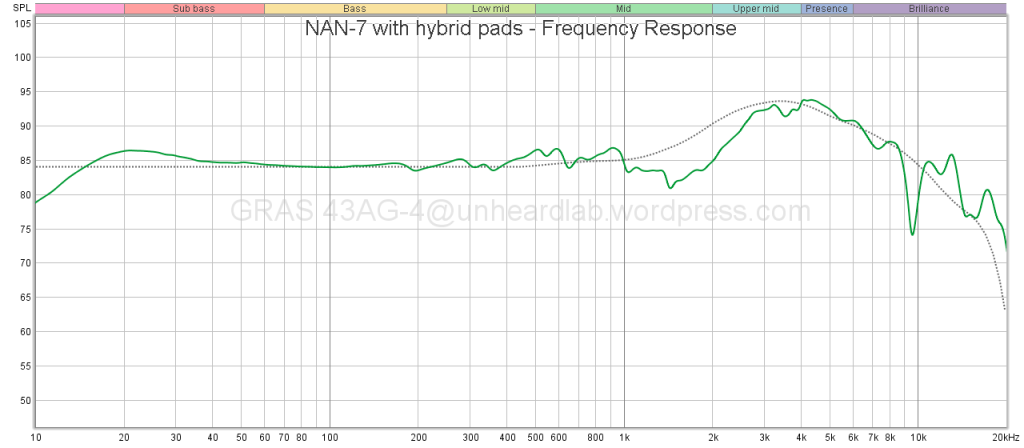
note: bass extension cutoff is 10hz instead of 20hz on Squiglink, so as to fully capture frequencies which though may not outside of ‘audible range’, may be felt by our ears, bones and muscles and enhance the sense of ‘impact’.
Positional Variation:
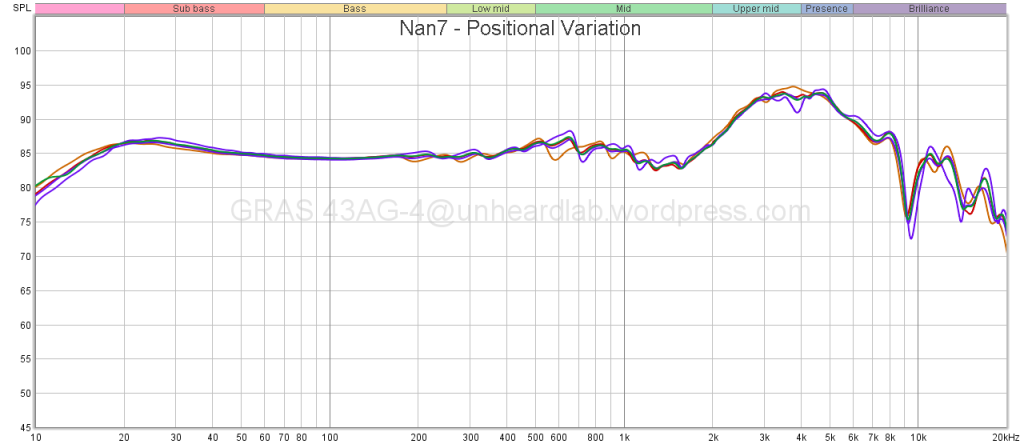
note: this graph shows how the tonality might be affected when you wear the headphones differently on the head.
Leakage Test:
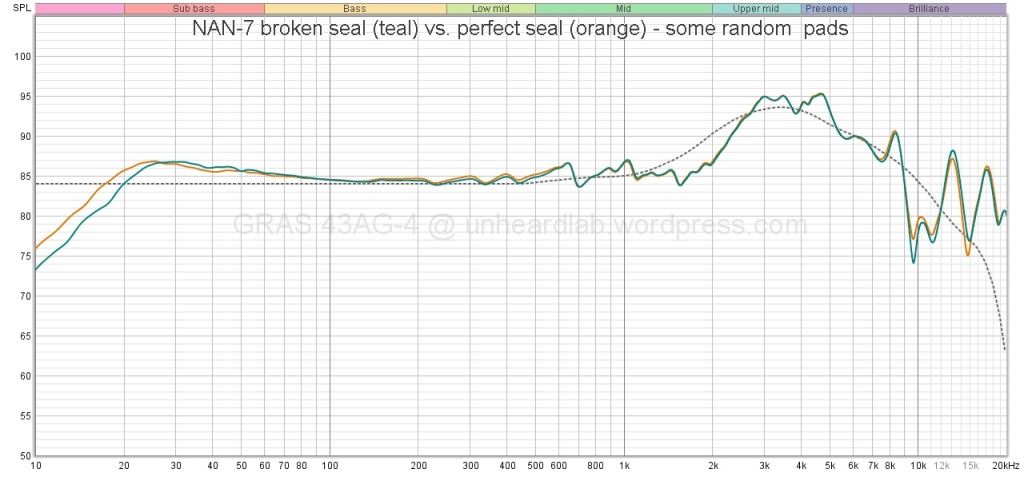
note: this graph demonstrates how a small leakage (simulated using thin-armed glasses) can result in FR change.
Impulse Response:
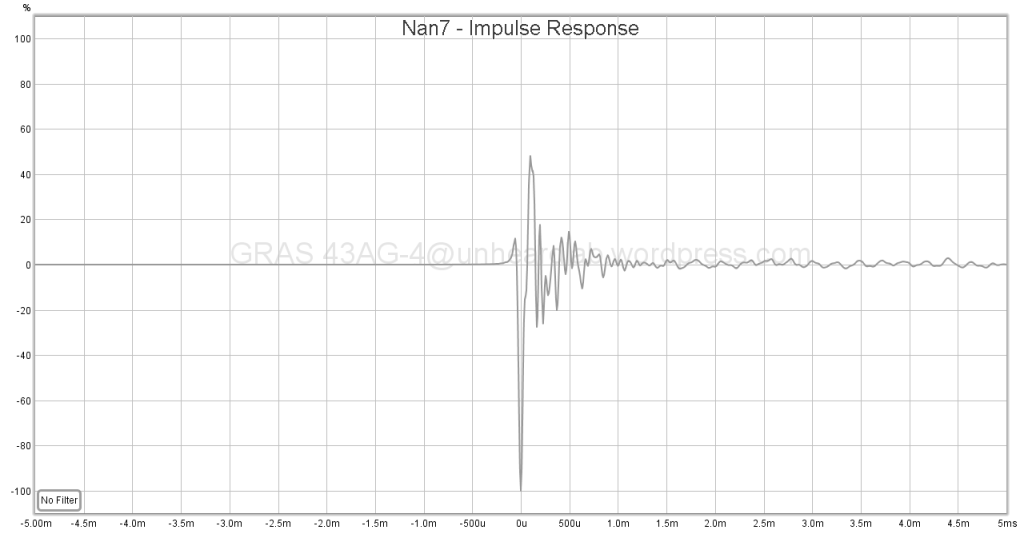
note: impulse response gives time-domain information about the transducer movement after a test tone is played. It should mainly be read for detecting polarity.
Like the HE-6 series, the NAN-6 and the Susvara, polarity is inverted on the NAN-7.
Channel Matching:
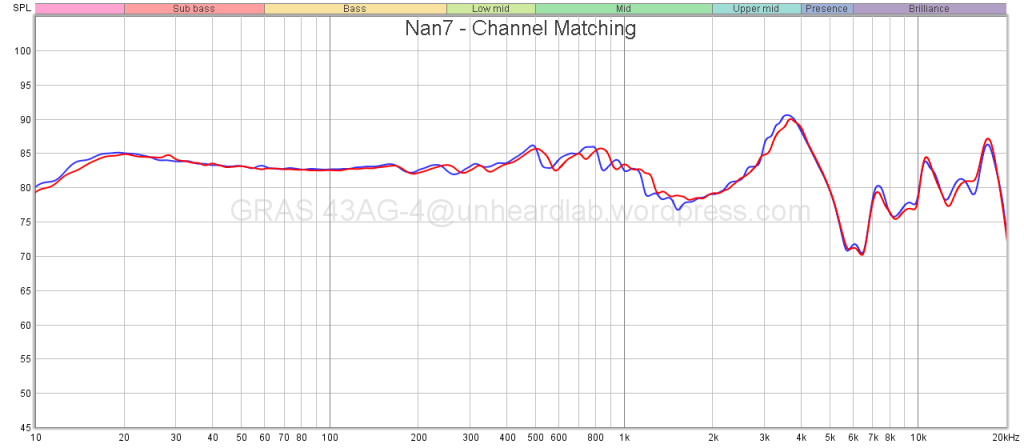
note: channel matching graphs DOES NOT RELATE TO TONALITY. A specialised configuration is used to capture channel differences to mitigate the interference from positioning on rig, directional sensitivity, and the asymmetricity in GRAS pinnae design (legacy of the Kemar). The Left (blue) and Right (red) channels are measured on a flat plate coupler with IEC60318-4 ear simulator.
END OF ARTICLE
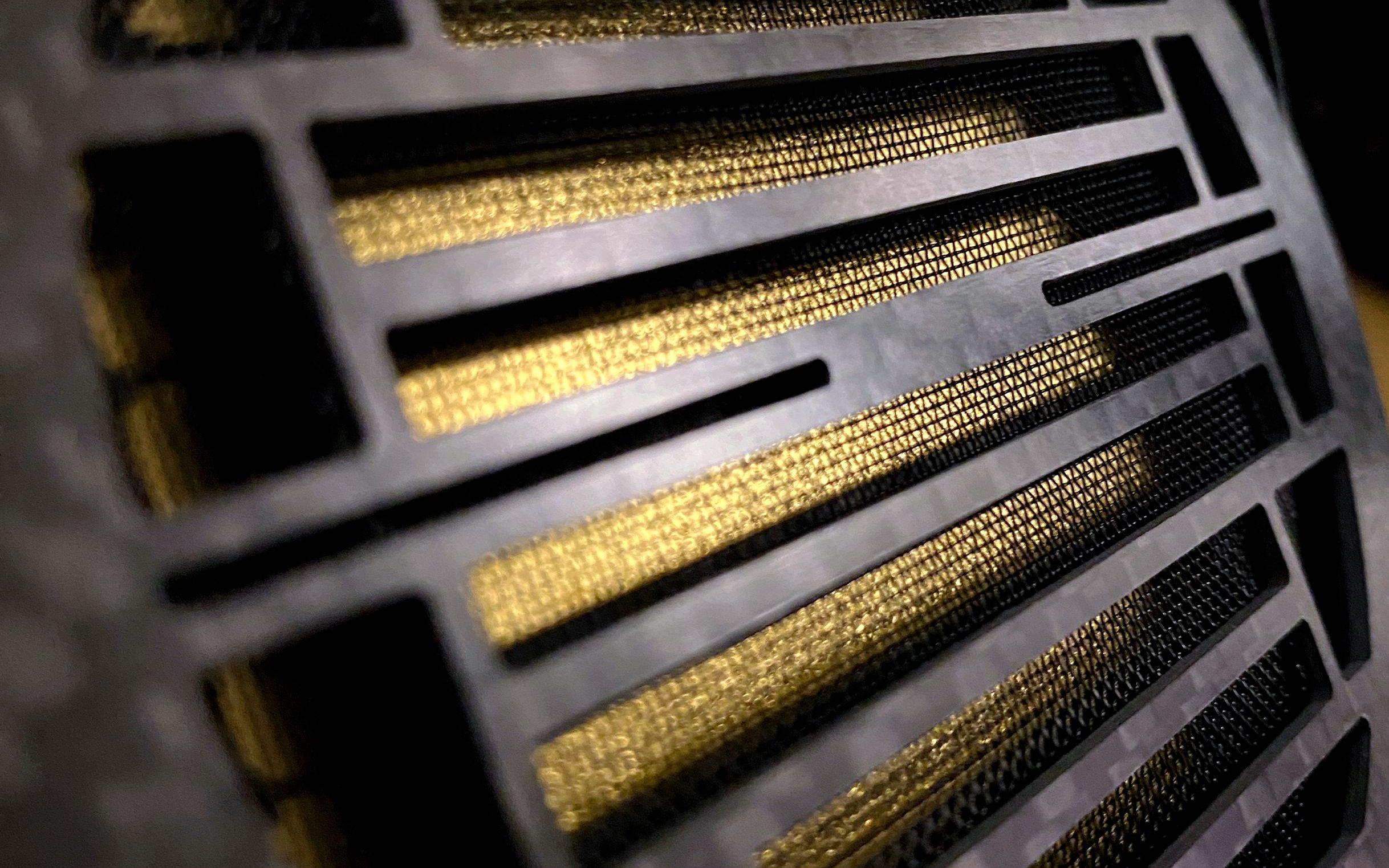
Feel free to leave a like or comment... let me know what you want to read more about
— — — — — — — — — — —
EDIT 24th Apr 2023:
I was asked where I got my unit. I purchased mine directly from the manufacturer’s Taobao store and used a parcel-forwarding service to ship it to Australia. For those proficient in using Taobao, the cost is significantly more advantageous than buying from Aliexpress resellers.
EDIT 2nd Nov 2023:

I wonder why they are inverting polarity.
Doing my own listening test I found it to be detectable sometimes. But most of the time not really it depends on the music I guess.
But then what’s the point.
LikeLike
Great to see you here!
It’s most certainly a design choice, although neither Hifiman nor A-NAN has provided a detailed account as to why. Inverting the polarity wouldn’t make much sense if the diaphragm were positioned exactly in the center of the magnet structure, or at least that’s what I’ve been told and tend to believe. I’ve been speculating that it could be related to factors like magnet array design, stator limits, diaphragm excursion, among other structural factors. There should be certain benefits to the design for it to be adopted.
You’re correct that absolute polarity can be audible with some very specific tones (those with asymmetrical waveforms). When it comes to music, the effect is much more subtle or inaudible most of the time.
Interestingly, my unit from the latest batch of HE6SE V2 has normal polarity, while my earlier unit had inverted polarity. Just a little side note.
LikeLiked by 1 person
“Interestingly, my unit from the latest batch of HE6SE V2 has normal polarity, while my earlier unit had inverted polarity. Just a little side note.”
That’s interesting one. I wonder what outcome would be if we check for polarity for example on bigger number of the units like 1k or 10k of the headphones and from different batch productions.
Having known Hifiman quality issues I wonder if there is a smidge chance that inverted polarity is just a quality issue rather than design choice.
LikeLike
Yeah it’s indeed possible that QC is the culprit, though considering that measurements by others (such as Tyll’s meaurement of the HE6 OG and HTL’s measurement of the Susvara) have consistently documented inverted polarity, I tend to believe it’s a design choice, at least for models other than the latest HE6SE V2. In addition to hifimans, other headphones with inverted polarity that I’ve measured include the Stax SR-009, Audeze LCD-5 & CRBN, Enigma Acoustics Dharma, and Focal Radiance. It seems that a fair amount of multi-driver IEMs are also designed this way, as well as a small number of DACs and AMPs.
LikeLike
Out of all the pads you measured, what is your favourite pads?
LikeLike
Hi Zeno. It’s probably the ZMF Universe perf lambskin or the Pali pads for modern genres and the Susvara/Stock hybrid pads for classical/instrumental.
That being said the NAN-7 actually pairs quite well with a lot of the pads thanks to its rather neutral tuning. I think it depends more on your personal perference for the tonal balance.
Hope that helps. “)
LikeLike
what do you think about the Yaxi alcantara pads? does it perform similar to the susvara pads?
LikeLike
I find it decently neutral and a bit cleaner than the stock hybrid pads. It’s also super comfortable. The Susvara pads are still the most ‘Hifiman’ sounding pad (if this makes sense), so I guess they are not very similar in this regard.
LikeLike
Will you be writing another review on the different pads on Nan-7?
LikeLiked by 1 person
Am happy to. Maybe not a review like this one but a shorter one on final thoughts and pad-rolling. ”)
LikeLiked by 1 person
Where do you get the 1688 hybrid solid pads? i can’t seem to find it
LikeLike
From this link, the last colour option (CNY30 is for each pad).
(Disclaimer: non-affiliated link, there’s no relations between me and the merchant in any way)
LikeLike
Thank you for this article. I am just a novice but I have the Nan-7 out on rent for the next few days. Your article really resonated with me as (the parts I grasp, again I am a novice) are also things I noticed on my first listen. I’m surprised how neutral and gentle the headphones are while maintaining a beautiful sense of space, depth and especially detail retrieval. Treble is sparkly but not bright which perfectly aligns with my personal taste. Mids seem well placed though, I really like male vocals on these headphones.
Where my intial impression differs is with the bass. While I don’t find the bass lacking, and it absolutely nails the speed and punchlines I do find it’s a bit light in the sub-bass. Since I’m out traveling, I only have the BTR7 on hand, do you think a dedicated desktop amp would aid in making the NAN-7 sound a bit fuller there? I’m not maxing the volume on the BTR7, though I do need to raise it to about 80-90% for a dynamic listening experience.
Just wondering, since I may pull the trigger on these regardless. I really got a ToTL sense of these headphones. A bit like if a HD800S, Susvara and LCD-X had a baby. But again, I’m not the most critical listener. Take that with a fair bit of salt.
LikeLike
Hi there! I’m glad you found the review useful.
Your impressions about the subbass might indeed have something to do with the source. Rated at 14ohms and 100db/V, the NAN-7 is VERY current-hungry. As such, we need a source that can provide an ample amount of current into a 14ohm load, which can often be a challenge for portable devices. So, I do recommend trying it on a desktop amp.
But then again, perception of bass quantity is a relative thing. Compared to most open-back planars like the HE6se/Susvara or the LCD series, I think the NAN-7 has a discernibly stronger subbass kick and rumble. However, it might not reach the same level as closed-back dynamic headphones or speakers.
Lastly, I really agree with your take – the NAN-7 does feel like something between the HD800S, Susvara, and LCD-X. You should have faith in your ears. 😉
LikeLike
try to EQ it,
Pre amp -8,
20hz +3db, Q value 1
40hz +6db, Q value 0.8
80hz +3db, Q value 1
200hz -1db, Q value 1
LikeLike
Unfortunately my time with the NAN-7 has ended but I did give your suggestion a quick try. Sounded interesting but I really only had a minute or two. Do you own these headphones too? Do you like them?
LikeLike
HAHAHA, i like it so much that i bought another one.
i have a new EQ setting for bass.
Pre amp -11,
20hz +4db, Q value 1
42hz +8db, Q value 0.7
80hz +3db, Q value 1
120hz +2db, Q value 1
200hz -1.5db, Q value 1
LikeLike
I just tried this, and I must say boy that is some serious bass lol.
I am on the RME ADI-2 dac fs. Sometimes I crank up 80hz by 4-5db for a kick back listen. Boosting the subbass is fun too though, and I do that to a lot of headphones.
But yeah, the bottom line is that the NAN-7 handles EQ really well.
LikeLike
Hi Sai, thanks for being so active in the comments. I’m gonna pull the trigger on these but I really had my eye on the Woo Audio WA-7 Fireflies (Gen 2 or 3). I’ve heard that tube amps don’t play well with planars due to their low impedance but I’ve also heard the Fireflies actually do pretty well so I’m not sure what to believe. You mentioned pairing the headphones with a tube amplifier in the comments so I wanted to quickly gather your thoughts on this combo.
LikeLike
Hahaha always here to help! I’ve not had a listen to the WA-7 personally, so unfortunately I can’t give you a definitive take on it. But you’re right in that tube amps and planars can sometimes be an odd match due to the impedance mismatch, potentially leading to less power and more harmonic distortion. But sometimes, they might just produce the sound you love. A friend of mine is mad about tube amps, and I’ve given the NAN-7 a go with some of his gear – it sounded pretty good. From my experience, as long as it’s not an OTL design, the impedance mismatch might not be a big deal. You also have the option to use tube amp as pre-amp and pair it with a low output impedance solid state amp that is readily available at reasonable prices nowadays. Ultimately, it’s all about what sounds good to you, right?
LikeLike
What a great review, congratulations! How comfortable are they? How is the clamping force and weight distributed? I’d love to hear how it compares to Arya in that regard. Also, how do they compare to Arya regarding soundstage and refinement? I assume the Nan are more natural sounding, but I’d love to know if they can compete with Arya in those aspects, thanks!
LikeLike
Hey I’m glad you found it useful!
You’re right, I didn’t really delve into comfort in the review, but it’s definitely one of the Nan-7’s strong points. At around 400-420g (depending on the pads), it’s pretty light compared to most other double-sided magnet planars. Heck, even compared to dynamic headphones, it’s not overly heavy. The headband is pretty much what you get with the Audeze suspension headband, with the only difference being that the leather strap is thicker and a bit stiffer. Don’t know if I have a big head or what but I find it very comfortable.
Now, the Arya and the rest of the egg-shaped Hifimans are a whole different breed. They have a sound character that caters to different tastes – they’re brighter, airier, sharper, just more flavourful in general. The Nan-7, on the other hand, is more in line with the HE6 series – its tuning is a lot more neutral (or conservative, depending on who you ask). There’s a stronger bass and mids presence, and the treble is more tamed and true to the recording.
So if you’re torn between the Arya and the Nan-7, think of them as more like complementary headphones than direct competitors. If it were up to me, I’d be pretty happy to have the Nan-7 alongside an Ananda or the Edition XS. That could be a pretty solid lineup.
LikeLike
Thanks for the prompt reply! I actually have Aryas, but I’m not completely happy with the stock frequency response, it’s a bit spicy up there. Would you say Arya’s soundstag eis much wider than NAN’s?
LikeLike
You’re welcome mate. Indeed the Arya’s treble can be a bit much for some, especially above 10kHz. Though it also depends on which version of the Arya you have.
As for soundstage, I’d say the horizontal stage of the Nan-7 is about on par with the Arya Stealth, which I’m most familiar with. The Nan-7 takes the cake when it comes to stage depth, while the Arya has the edge in stage height (the egg-shaped Hifimans are tough to beat in this area… maybe except for the Meze Empyrean/Elite). The Nan-7 might not sound as ethereal, but the way the sound can disperse into the far reaches of the sound field is quite remarkable.
LikeLike
Super, thanks!
LikeLike
Do you think the NAN7’s technical level is similar to the Susvara?
LikeLike
Spicy, but yeah I do find the two comparable in many ways. 😉
While the Susvara might still have the slight upper hand but hey we can’t forget the price difference…
LikeLike
Hello again. Have yo compared NAN-7 and DCA Expanse?
Because of financial reasons I’m thinking about selling Expanse and getting NAN-7 (maybe use some small eq to tailor the sound)
LikeLike
Great to see you again. Before I answer your question, I think it’s important to share my thoughts on the Expanse.
I’ve had the chance to try out the Expanse, but I’ve not owned it personally. I’m not sure if the differences I note are due to unit variation or simply that the Expanse doesn’t mesh well with my ears. To me, they don’t sound as ‘balanced’ as measurements suggest. The mids are fine – very clean, neutral and vivid. But the highs lean towards the bright and dry side. Bass quantity is there but it’s not very punchy. This might have a lot to do with their AMTS technology which effectively serves as a passive filter altering the pinna-related transfer function (i.e., enhancing or attenuating certain regions of pinna gain). The high film tension in DCA drivers could result in greater variation among listeners than less damped drivers. So if unit variation isn’t the main factor here, it might just be that my ears don’t get along well with the Expanse. That said, the Expanse does offer excellent clarity and separation of instruments, and it certainly sounds very clean and detailed.
In comparison, the NAN-7 has more bass, with more rumble and punch, which could make it sound thicker and less ‘clean’ compared to the Expanse. Technical persformance is on a similar level overall, but I don’t want to make a definitive statement, as I would need to compare the Expanse side by side for a longer period for a thorough assessment. But I hope my comments above, along with the review, provide some sort of reference.
But then again, if the Expanse is a good fit for you, then by all means stick with it. The NAN-7 is a very different headphone, and if you like the Expanse, the NAN-7 might not be to your liking. They’re best seen as complementary headphones.
If you’re really keen on trying out the NAN-7, maybe consider comparing both and then decide? One of the best things of this hobby is that there’s a lively used market you can take advantage of. 😉
LikeLike
That’s what I’m planing to do. Order nan-7 (preferably second hand but that is going to be hard). Back in the day I had another Chi-fi headphone: Music Master e1000i (or smth) and it was very very good. In the past I was biased towards noname brands and definitely prices. Now with time perspective I can see that indeed it was a marvelous headphone.
As for the Expanse. Sometimes highs can be a bit too much, ariund 4-5-6 khz area.
As for the bass, they are still very seal dependent just like Stealth (my previous headphones) but when you improve the seal – by bending the rods or using additional screws (they are provided by DCA when you ask) the seal improves and they become bass monsters alas not as punchy as some dynamic or even ortho offerings (btw I really didn’t like abys 1266, too wonky stock tuning with many sounds missing)
LikeLike
I see. I do recall getting a good seal with the Expanse, but I wasn’t aware of the benefits of the extra screws. Maybe I should consider giving it another try someday. What bothered me most when I heard it was actually the excess energy in the upper treble between 9-12khz. I found the 4-6khz overshoot a little fatiguing (like the Etymotics), but not problematic.
I’ve also been interested in the Music Master headphones, but their prices have skyrocketed over the past few years. Nowadays their TOTL model is even pricier than the Susvara… though I hope to have the opportunity to demo or borrow a set at some point. So, yes, boutique manufacturers do sometimes produce excellent products; it just requires some digging haha.
LikeLike
One more question. What about higher frequencies and sibilants on nan7 vs expanse? Any thoughts which one seems to be darker/smoother there?
LikeLike
I don’t find the NAN-7 a sibilant headphone, unless the vocal is mastered to be artificially
bright and aggressive where sibilance can peak around 10-11kHz and above. This range IMO is a common issue for a lot of planar headphones (like Hifimans, LCD-X, and DCA). Compared to the HE6se and the Susvara, the NAN-7 is noticeably smoother in the lower treble range where sibilance typically is (ie. 6-9khz). I did find the Expanse to lean a bit more towards the sibilant side, although I don’t think of it as a sibilant headphone in its own right.
LikeLike
If there’s a chance you should try out flannel earpads on nan’s taobao site, out of all the pads I purchased, I prefer the flannel earpads, they are cheap and amazing
LikeLike
Do you mean the round velour one that comes with the NAN-6?
LikeLike
I not really sure, but looks like the beyerdynamic earpad
LikeLike
Then I believe so. They are measured here, named slightly differently. I did try it briefly and find them to be a decent option, more on the uncoloured side. Let me spent more time with them…!
LikeLike
They also make the subbass more pronoun, idk is it because of the open nature of the pads, the subbass resonance is more apparent in these pads, especially so if you do use EQ like me.
LikeLike
I cannot find them on Taobao. Do you have a link?
LikeLike
Just looked and they seem to be out of stock atm. There are generic ones available on Aliexpress that look just the same, but I can’t guarantee they are made with the exact same material/foam.
LikeLike
Ah, indeed. The bass becomes even more punchy and satisfying. I only wish they come in a slightly thicker or angled form.
LikeLike
oh right, you should also try using the N1266 pads on Tanglaoshi Headphone, it have interesting result on the bass
LikeLike
Will do haha, thanks for the idea. Out of curiosity, which headphone of Tang did you purchase?
LikeLike
I bought the HC V2.0 version
LikeLike
nan-7 compared with tang v50h, which one have more bass impact and soundstage?
LikeLike
Thanks for the thorough review :). What amplifier specifically, but your input chain in general did you use while listening? Thanks
LikeLike
Thanks for reading!
I mostly used the RME ADI-2 DAC FS and the Topping A90 Discrete as my neutral reference. Although I have also owned stuff like the Holo Spring 3 R2R DAC and some tube amps, I tend to evaluate headphones on gears that are consider more transparent.
LikeLike
Thanks pal 🙂 Just ordered a pair from pandabuy. Do you think the RME could power it nicely on its own, or is the A90D a must in your opinion?
LikeLike
Ah nice – keen to hear what you think of them! 😉
I mean you don’t absolutely need a specific amp or anything. The RME head amp is decent, but it might not hold up if you’re into cranking the volume or using a bass boost. I’d recommend going for an amp with decent current output at lower impedance loads, like the L70 or similar models. You get the idea.
LikeLike
Hi Sai,
Been playing with the Nan7 for a few days and its genuinely as good as you say. Terrific value for the money. I’ve also applied corrective EQ based on your graphs here and it helps tremendously. Thanks for your review 🙂 I’ve tried it with a few amps, notably the A90 and the SMSL H0300. A90 wins on image size and details but is flat as a pancake soundstage wise and somehow I get fatigued really quickly. I’m assuming there’s some distortion in the upper frequencies that my brain doesn’t like. So I’m now on the hunt for another miracle, a best in class amp for less than a grand. Can you make lightening strike twice? 😀 *crosses fingers*
Chris
LikeLike
Hey Chris,
I’m happy to hear you’re enjoying the NAN-7!
I haven’t paired them with the A90, but when I had the A90 discrete, it seemed alright to me. Amps and DACs with lower distortion might come across as less ‘euphoric’ or warm, which makes sense given how most music follows a downward tilt. Throw in more harmonics, and you get a warmer mix. Also, if you’re coming from dynamic headphones, planars (and estats) do have a bit more kick in the upper treble, which can take some getting used to. It might be worth it to given EQ another shot, which could help locating issues you perceive in the upper octaves.
Back to amps. From what I’ve tested the Singxer SA-1 stands out as one of the low distortion amps that is on the warm/smooth side. Brands like Schiit and Burson also seem to be popular choices. However, I’d be remiss to recommend them without having owned them myself.
Hope this helps 😉
Sai
LikeLike
Thanks Sai, I’ve decided to go with the Flux FA-10 Pro. I’ll let you know my findings 🙂 looking forward to the pad rolling review.
LikeLike
So how does Nan-7 is compared to the EH-1? :3
LikeLike
Hahaha you caught me! Yeah, they’re a bit like chalk and cheese. The NAN-7 is about planar vibe with bass slam and mids density. The EH-1 has that estat speed and airiness you’d expect, while sounding very natural overall. Kind of like an estat version of the HD600 is how I feel at this point.
LikeLike
Hello I have another question,
When are you gonna post about the pad-rolling of Nan-7.
How do you compared the bass of Fostex TH-900 and Nan-7 (with eq) ?
LikeLike
You’ve got great timing. The article on pad-rolling will be out next week.
Now, talking about bass, both the TH900 (a DD) and the NAN-7 (a planar) shine in their own ways. They handle bass EQ brilliantly free from distortion or clipping (unless we’re venturing into the >10db range). Both got deep, punchy, and powerful bass after EQ. The NAN-7 has more naturally diffused airiness and extension, whereas the TH900 feels like there’s more weight to it. Hope that paints a picture.
LikeLike
Just a quick update: pad-rolling article will be out by next weekend as I have something important arriving in the next few days.
Apologies for the delay.
LikeLike
When will it be ready :3
LikeLike
Eyeing tomorrow for it T_T
LikeLike
Just got back from a business trip… Here it is.
LikeLike
Hi.
Would this make sense for metal music or should one try to look for Nan-6 instead?
LikeLike
Depends on your preference. If you’re after a more balanced or somewhat refined take on metal, the NAN-6 could be a good shout. On the other hand, the NAN-7 delivers more punch and sharper clarity, great for capturing that raw energy and edginess of metal.
LikeLike
Thanks for answering, man. I was a little bit under the impression that NAN-6 was like he-6 (very good for metal) and NAN-7 more towards Hifiman HE-1000 series (not good for metal) Maybe this is not accurate? Do you think my Violectric V200 amp would be enough for NAN-7, it gives only 780 mW to 16 ohm?
LikeLike
Ah I see where you’re coming from. The NAN-6 is similar to the HE-6 in terms of overall sound profile, but qutie different in terms of style/presentation.
While having similar tonal balance, the NAN-6 leans towards a warmer and smoother sound, slightly softening the sharper edges found in the HE-6. So, the HE-6 is still more resolving/incisive. The NAN-6 might be better suited for classic rock and jazz than metal. As for the NAN-7, it aligns more with the HE-6 vibe, with a stronger bass and more tamed highs.
I haven’t tried the V200 so unfortunately cannot comment on that. Violectric amps are mostly designed for high impedance cans though, IIRC.
LikeLike
NAN-7 would probably be perfect for my preferences it seems. Youre corerct on Violectric, its great on my 300 ohm Senns and 250 Beyers. Next I have to try and learn how to order from Taobao. Process seems to be extremely hard. Depending how much forward services cost you can save something like 250 euro compared to Aliexpress.
LikeLike
Yeah that’s true. If it helps I think Nan is working on his own Aliexpress store. No clue when that will be available though… hopefully soon
LikeLike
Hello sir!
Is this better than OG HE-6?
LikeLike
Hi there. It’s a bit difficult to say one is better or worse than the other haha. I’m more familiar with the HE6se V1&V2 and the Susvara, as I haven’t heard the HE6 OG for a while now. I think the NAN-7 is built better and sonically about side-grade as the HE6 OG. The main differences are in how they present things.
The NAN-7 has more subbass oomph where as the HE6 OG is tighter. The sense of detail and resolution is about on par, both are excellent and a bit better than the SE series. What I like the most about the OG is how precise the imaging can be and how sharp the edges are on instruments. But these could also be downsides with certain types of music like soft jazz or vocals, which could come off as a little intense. The NAN-7 is more reserved in the treble response. Vocals are smoother and have a bit more body to them, while still sounding clear and articulate.
I’m looking for a pair of the HE6 OG on the used market but they are quite rare these days, let alone in good condition (and from Australia).
LikeLike
Should we try to work out some kind of trade? You would have to give some money too of course. Were on different continent too. Could it work? -Mikko-

LikeLike
Hi Mikko! I haven’t thought of letting go of my NAN-7 yet, but feel free to drop me a PM here see if we can make something happen. 🙂
LikeLike